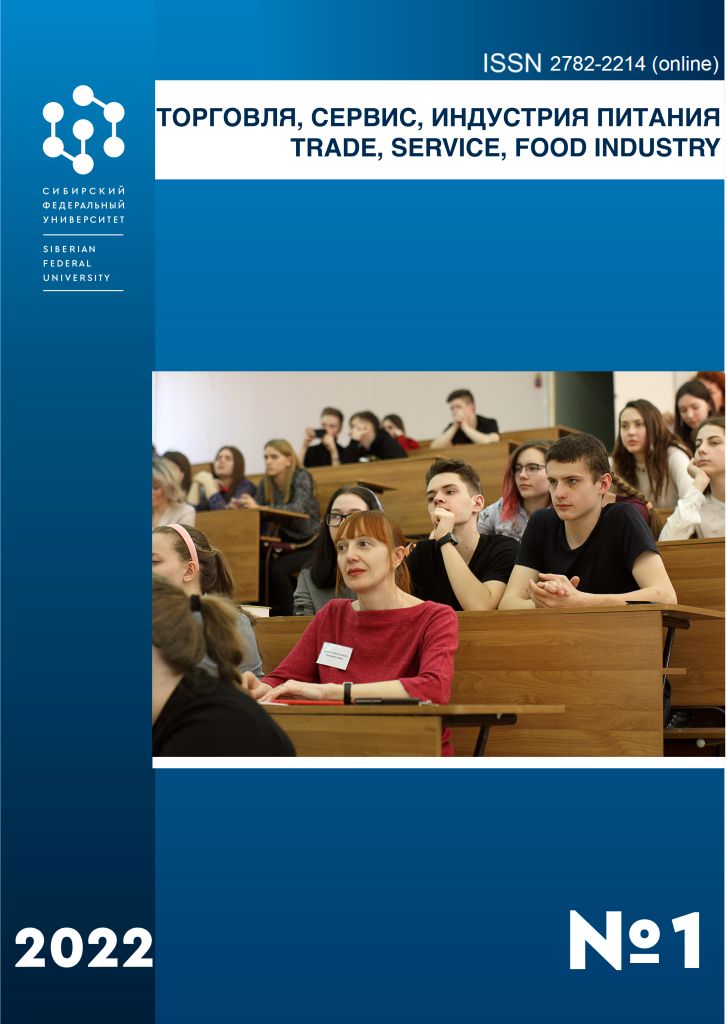Russian Federation
CSCSTI 65.63
Due to the growing interest of consumers in healthy food products, it is important not only to develop new types of useful goods, but also to pay attention to the properties of existing products, one of which is butter. The possible sale of low-quality and potentially dangerous products determines the relevance of the research on the chosen topic. The purpose of the study was the commodity expertise of butter, including microbiological safety, produced in the Siberian region. Five samples of butter were selected as research objects. During the commodity examination and the samples studied, the following was revealed. According to the organoleptic and physico-chemical quality indicators, all the studied samples comply with the requirements of the state standard for butter. The results of the definitions and comparisons of the actual values of microbiological safety indicators with the requirements of regulatory documents showed that all the products considered were free of pathogenic microorganisms - L. monocytogenes and bacteria of the genus Salmonella. However, in part of the butter samples, the content of sanitary-indicative microorganisms was exceeded. The presence of E. coli bacteria in the production of three out of five samples was revealed, but does not exceed the norm of the technical regulations. Yeast and mold were found in all butter samples, but in two of the five samples, the amounts of these micro-organisms were found in quantities significantly exceeding the norm. A microbiological study of product safety made it possible to make an assumption about a possible violation of the sanitary regime of the production of these samples and about the influence of the packaging method on the growth and development of microorganisms. The obtained results indicate the need to control the microbiological parameters of butter, both at the production stage and at the product sale stage.
butter, food quality, microbiological safety indicators
1. GOST 32261-2013 Butter. Specifications. Input. 07/01/2015. Moscow, 2014. 18 p.
2. GOST R 58185-2018 Purchase of samples for consumer testing of products. Good Practice Guide. Input. 03/01/2019. Moscow, 2018. 20 p.
3. GOST 32901-2014 Milk and dairy products. Methods of microbiological analysis. Input. 01/01/2016. Moscow, 27 p.
4. GOST 31659-2012 (ISO 6579:2002) GOST 31659-2012 Food products. Method for detection of bacteria of the genus Salmonella. Input. 07/01/2013. Moscow, 21 p.
5. GOST 30347-2016 Milk and dairy products. Methods for determining Staphylococcus aureus. Input. 09/01/2017. Moscow, 14 p.
6. GOST 32031-2012 Food products. Methods for detection of bacteria Listeria Monocytogenes. Input. 07/01/2014. Moscow, 27 p.
7. GOST 33566-2015 Milk and dairy products. Determination of yeasts and molds. Input. 07/01/2016. Moscow, 14 p.
8. TR CU 033/2013: Technical Regulations of the Customs Union "On the safety of milk and dairy products" [Electronic resource]: adopted by the Decision of the Council of the Eurasian Economic Commission dated October 2, 2013 No. 67. - Access mode: http:// docs.cntd.ru/document/499050562.
9. Veretnova, O. Yu., Palatkina, P. D. (2020). Analysis of the range of butter sold in the retail network of Krasnoyarsk [Electronic resource]. In: Problems of development of the market for goods and services: prospects and possibilities sti subjects of the Russian Federation / ed. by Yu. Yu.Suslova; Krasnoyarsk. 588-592.
10. Market overview of butter, margarine and spreads (2016). In: Oil and fat industry. -. 4. 36-42.
11. Goroshchenko, L. G. (2019). Import and export of butter in 2017. In: Cheese making and butter making. -1. 52-54.
12. Goroshchenko, L. G. (2018). Price situation in the Russian market of butter, cheeses and cottage cheese. In: Cheese making and butter making. - 5. 4-8.
13. Poznyakovsky, V. M. (2015). Safety of food products (with the basics of nutrition): textbook. Moscow, 2015. 271 p.
14. Kastornykh, M. S., Kuzmina, V. A., Puchkova, Yu. S. (2012). Commodity science and examination of food fats, milk and dairy products. - Moscow. 328 p.
15. Volodin, D.N. (2019). Production of butter as an element of the organization of complex processing of dairy raw materials. In: Cheese and butter. -1. 55-56.
16. Rodnikova, A. (2017). Influence of packaging on the rate of formation of defects in butter. In: Container and packaging. 1. 18-19.
17. Rybalova, T. I. (2019). Cheese-making and butter-making: results of 2018. In: Cheese-making and butter-making. -1. P. 4-8.
18. Topnikova, E. V. (2016). Enrichment of butter products with functional ingredients. In: Cheese making and butter making. 2. 16-19.
19. Chemical composition of Russian food products(2002). Ed. by prof. I. M. Skurikhina. Moscow/. 236 p.
20. Encyclopedia of nutrition: in 10 volumes. Vol. 3. Characteristics of food products (2019). Ed. by A.I. Cherevko, V.M. Mikhailov. Moscow. 732 p.








